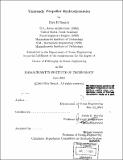Unsteady propeller hydrodynamics by Dirk H. Renick.
Author(s)
Renick, Dirk Hampton, 1970-
DownloadFull printable version (6.655Mb)
Other Contributors
Massachusetts Institute of Technology. Dept. of Ocean Engineering.
Advisor
Justin E. Kerwin.
Terms of use
Metadata
Show full item recordAbstract
One of the main problem affecting modern propulsor design engineers is the ability to quantitatively predict unsteady propeller forces for modern, multi-blade row, ducted propulsors operating in highly contracting flowfields. Current algorithms provide valuable insight into qualitative trendlines for these modern designs. This thesis has focused on the more accurate quantitative force prediction by introducing more physical modeling into the numerical computations, using more accurate analytical representation of continuous physical phenomena, whilst not increasing the usage complexity for the desktop engineer. This thesis developed several novel algorithms and techniques and applied them to build an evolutionary, general vortex-lattice lifting-surface propeller code. First, a general method to track the trajectory of individual wake singularity sheets and compute their influence velocities was evolved which reduces computation time, and dramatically increases the accuracy of the unsteady blade loading problem. To improve the general coupling technique between potential-based propeller codes and volumetric Reynolds-Averaged Navier-Stokes codes, a general analytic method based upon an elliptic integral method for the velocity induced by a vortex ring of unsteady harmonic strength to compute of the time-averaged induced velocities in the swept volume of the propeller was introduced which is more accurate, as demonstrated in model problems, and more robust, as indicated by improved convergence and accuracy in a fully three dimensional propeller code. (cont.) A discretized geometric technique was also created to internalize the coupling routines, making the code more robust, while decreasing the computation burden over currect methods. Finally, a higher order quadratic influence function technique was implemented within the wake to more accurately define the induction velocity at the trailing edge which has suffered in the past due to lack of discretization. These propeller propgram enhancements were fitted into a fully functional version of the Propeller Unsteady Forces (PUF)-series code, and coupled with a three dimensional RANS code.
Description
Thesis (Ph. D.)--Massachusetts Institute of Technology, Dept. of Ocean Engineering, 2001. Includes bibliographical references (leaves 129-132).
Date issued
2001Department
Massachusetts Institute of Technology. Department of Ocean EngineeringPublisher
Massachusetts Institute of Technology
Keywords
Ocean Engineering.